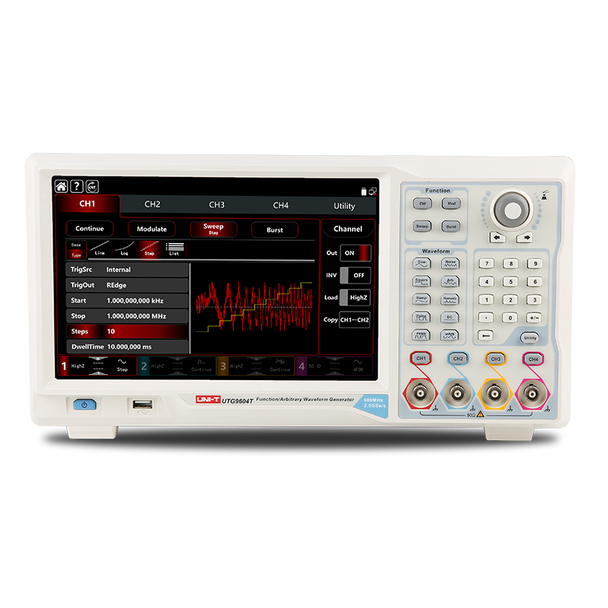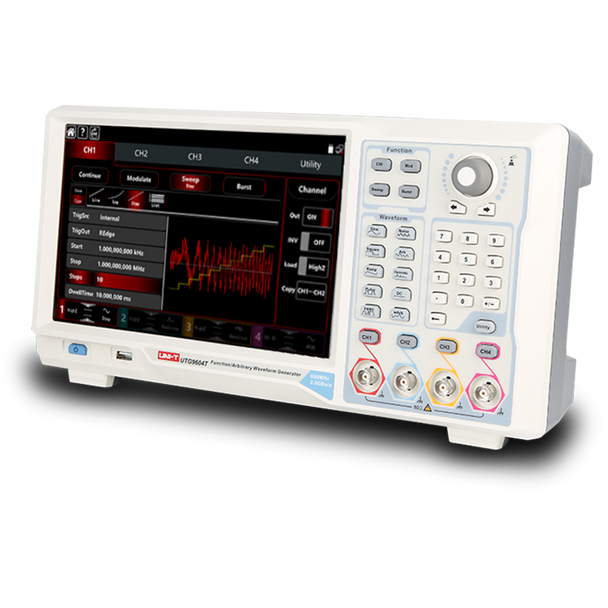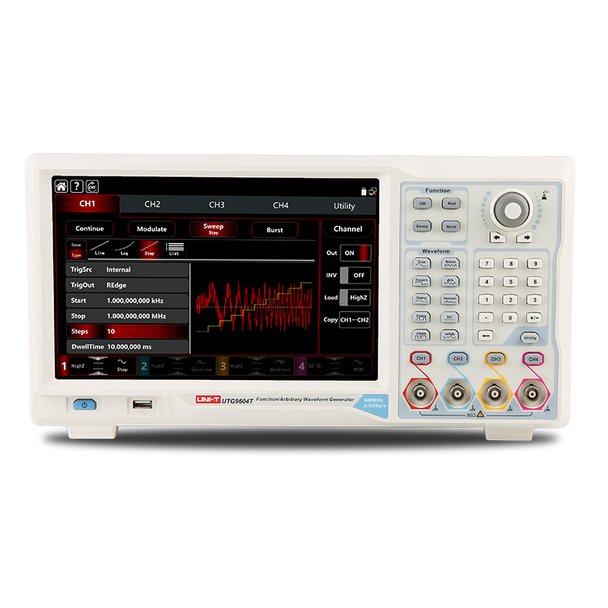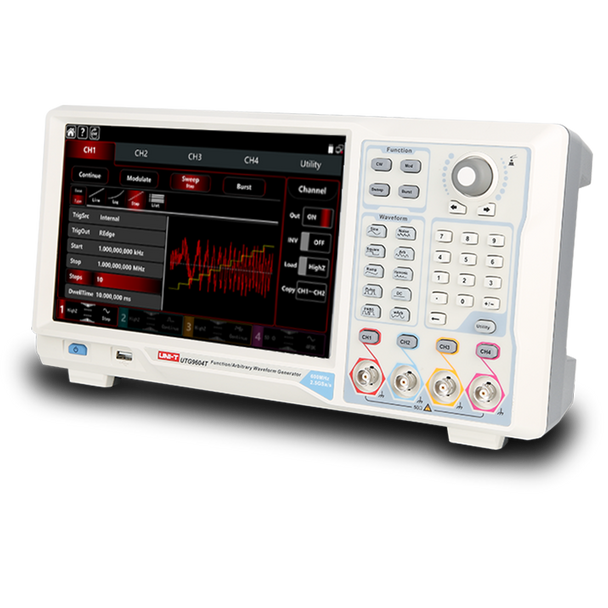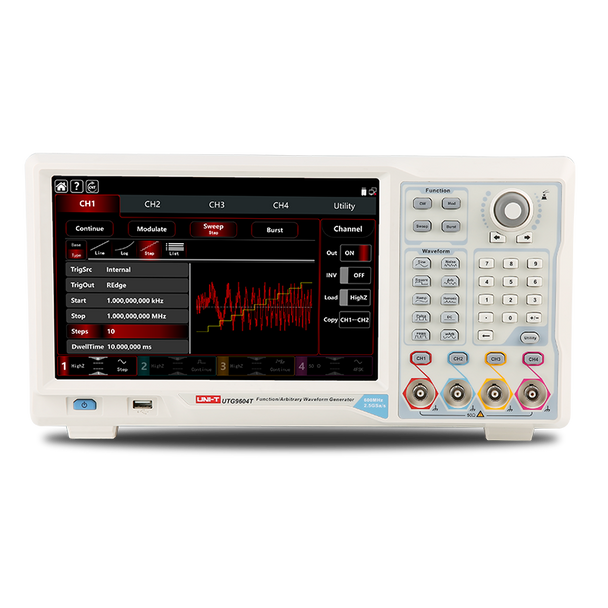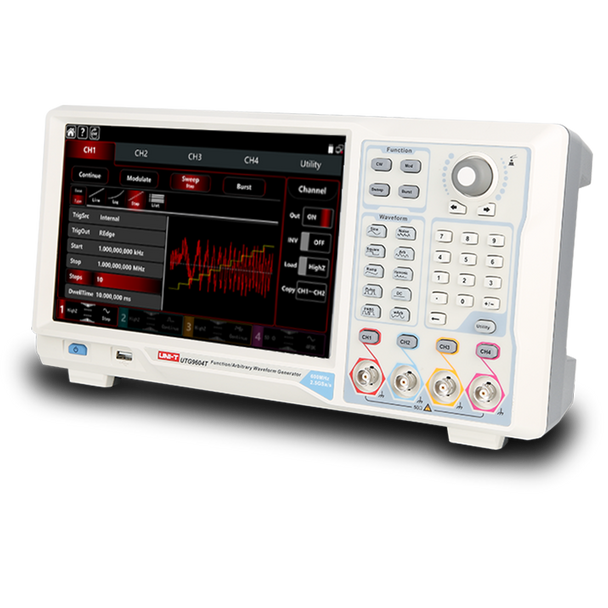Filter and sort
UTG9000T Series
-
UTG9354T Waveform Generator
Excl. VAT €2.439,00Excl. VAT €3.250,00Incl. 19% VAT €2.902,41
The Uni-Trend UTG9354T Performance-Series arbitrary waveform generator is built for high-precision signal testing. It delivers 350 MHz signal generation with a 2.5 GSa/s sampling rate, ensuring detailed and accurate waveform output.
Featuring 4 channels, 64 Mpts memory depth, and a 10.1-inch display, the UTG9354T is well-suited for complex signal analysis and generation. It supports a range of modulation types including AM, FM, PM, ASK, FSK, PSK, QPSK, and PWM, offering versatility for various testing scenarios.
-
UTG9504T Waveform Generator
Excl. VAT €5.075,00Incl. 19% VAT €6.039,25
The Uni-Trend UTG9504T Performance-Series arbitrary waveform generator is designed to enhance your testing capabilities with high precision and versatility. Generate 500 MHz signals with a sample rate of 2.5 GSa/s, offering exceptional clarity and accuracy.
500 MHz, 4 channels, 2.5 GSa/s, Memory Depth: 64 Mpts, 10.1-inch display, USB connectivity. The UTG9504T supports a range of modulation types, including AM, FM, PM, ASK, FSK, PSK, QPSK, PWM, and more.
-
UTG9604T Waveform Generator
Excl. VAT €5.470,00Incl. 19% VAT €6.509,30
The Uni-Trend UTG9604T delivers up to 600 MHz frequency with 2.5 GSa/s sampling, ensuring precise waveform generation. With 4 channels, 64 Mpts memory, and a 10.1″ display, it is built for advanced testing.
Supporting AM, FM, PM, ASK, FSK, PSK, QPSK, PWM, and more, the UTG9604T offers versatility for complex applications, making it a reliable tool for engineers and researchers.
Uni-T Buying Guide: Arbitrary Waveform Signal Generators (25MHz - 600MHz, Two-Channel)
Are you in the market for an Arbitrary Waveform Signal Generator? Look no further! Uni-T, a trusted name in electrical equipment, is here to help you make an informed decision. In this comprehensive buying guide, we'll cover the essential functions and features you should consider when choosing an Arbitrary Waveform Signal Generator in the 25MHz to 600MHz range with two channels. We'll also provide practical use cases for different bandwidth maximums, ensuring you get the most out of your investment.
Key Terms Explained:
1. Arbitrary Waveform:
An arbitrary waveform refers to a user-defined signal shape that can be generated by the device. It allows you to create custom waveforms tailored to your specific testing needs, making it a versatile tool for engineers.
2. Bandwidth:
Bandwidth is the range of frequencies that an arbitrary waveform signal generator can produce. It's crucial to choose a generator with sufficient bandwidth for your application, as it directly impacts the types of signals you can generate accurately.
3. Channels:
Channels represent the number of independent signal outputs the generator can produce simultaneously. In a two-channel generator, you can generate and control two different signals simultaneously, providing flexibility for various testing scenarios.
4. Amplitude Resolution:
Amplitude resolution is the smallest change in output voltage that the generator can produce. Higher resolution ensures precise control over signal amplitudes, crucial for demanding applications.
5. Sample Rate:
Sample rate refers to the number of data points per second used to represent the waveform. A higher sample rate enables the generator to produce more accurate and complex waveforms.
Key Functions and Features to Consider:
1. Bandwidth:
Select a generator with bandwidth that matches or exceeds your application requirements. For general-purpose applications, 25MHz may suffice, but for more complex designs, consider options in the 80MHz to 600MHz range.
2. Channels:
If you need to test multiple components or circuits simultaneously, a two-channel generator is ideal. Uni-T offers reliable two-channel options for your convenience.
3. Amplitude Resolution:
Look for generators with high amplitude resolution (e.g., 14 bits or higher) to ensure precise control over signal amplitudes, crucial for accurate testing and analysis.
4. Sample Rate:
Higher sample rates (typically 1GS/s or more) are essential for generating intricate waveforms with fine details. Choose a generator that suits your waveform complexity needs.
5. Modulation Capabilities:
Uni-T Waveform Generators can create the following modulation types (depending on model): AM (Amplitude Modulation), FM (Frequency Modulation), PM (Phase Modulation), ASK (Amplitude Shift Keying), FSK (Frequency Shift Keying), PSK (Phase Shift Keying), BPSK (Binary Phase Shift Keying), QPSK (Quadrature Phase Shift Keying), OSK (On-Off Keying), PWM (Pulse Width Modulation), SUM (Summation Modulation), QAM (Quadrature Amplitude Modulation).
Here's a brief explanation and practical application for each modulation type:
- AM (Amplitude Modulation): Varies the amplitude of a carrier signal according to the modulating signal. Practical application: AM radio broadcasting.
- FM (Frequency Modulation): Alters the frequency of the carrier signal in proportion to the modulating signal. Practical application: FM radio broadcasting.
- PM (Phase Modulation): Changes the phase of the carrier signal in response to the modulating signal. Practical application: PM is useful for generating stable frequencies.
- ASK (Amplitude Shift Keying): Switches between two or more discrete amplitudes to convey digital information. Practical application: Digital data transmission over optical fibers.
- FSK (Frequency Shift Keying): Shifts between two or more frequencies to represent digital data. Practical application: Used in telecommunication and RFID systems.
- PSK (Phase Shift Keying): Alters the phase of the carrier signal to encode digital data. Practical application: Used in Wi-Fi and Bluetooth communication.
- BPSK (Binary Phase Shift Keying): A special case of PSK with two phase states. Practical application: Satellite communication and GPS.
- QPSK (Quadrature Phase Shift Keying): Uses four phase states to encode digital data. Practical application: Digital satellite TV transmission.
- OSK (On-Off Keying): Modulates the carrier by switching it on and off. Practical application: Remote control systems.
- PWM (Pulse Width Modulation): Varies the width of pulse signals to control the average power delivered to a device. Practical application: Motor speed control in robotics.
- SUM (Summation Modulation): Combines two or more signals to create a new waveform. Practical application: Audio mixing and synthesizers.
- QAM (Quadrature Amplitude Modulation): Modifies both amplitude and phase to encode digital data. Practical application: Used in cable television and broadband communication.
In conclusion, when choosing an Arbitrary Waveform Signal Generator from Uni-T, consider your specific application needs, bandwidth requirements, and desired modulation capabilities. Uni-T's extensive range of reliable generators ensures you'll find the perfect solution for your engineering projects. Don't compromise on signal quality—choose Uni-T for your waveform generation needs.

